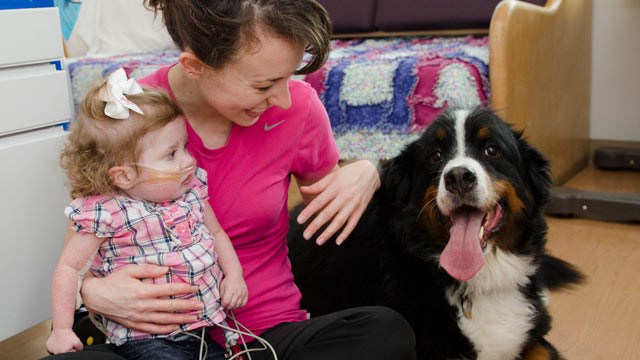Hospitals across the country use pet therapy programs to enrich patients’ lives, but increasingly, they are allowing patients’ own pets to visit during prolonged hospital stays. “Often there are people who are not doing well, and don’t respond to staff and people, but for some reason make an effort to speak when animals come around,” said veterinarian Lisa Portnoy, animal program director for the NIH Clinical Center. ABC News (6/22)
By DR. SHEILA REDDY, ABC News Medical Unit
Madison Fleaks had been in Texas Children’s Hospital in Houston for over six months waiting for a heart transplant. She was born with a congenital heart condition.
Not yet two years old, she may have forgotten much of her life at home. But she still remembered her two dogs; their photograph sat framed next to her hospital bed.
“If you said anything about the dogs, she would point and want to kiss the picture,” said her mother, Tabitha Fleaks. Madison has been in and out of hospitals, she said, enduring multiple surgeries.
“She has been sick her whole life. All she knows is me, her dad, and the two dogs.”
So when her dog Kodiak showed up in her hospital room one day, Madison was thrilled.
“It was amazing,” Fleaks said. “She just lit up. She literally screamed when he walked into the door.”
Texas Children’s is not the only institution to allow some patients to have visitors of the canine variety. ABC News reached out to hospitals around the country and found that many have pet therapy programs, in which a trained owner-volunteer will bring a dog to the hospital for patients to enjoy. These programs have been said to help patients with their mood, pain, and comfort levels.
“When there is a patient in the hospital that will be here for a significant amount of time, we think it is important for them to have their entire family here,” said Jamie Snow, Assistant Director of Child Life and Social Work at Texas Children’s Hospital. “And some people consider their pets family members.”
The program started at Texas Children’s four years ago, when administrators were approached by an organization called PAWS (Pets Are Wonderful Support) Houston, a non-profit organization the helps to sustain the relationships between pet owners and their pets during a prolonged hospitalization.
Here’s how it works: a social worker or child life specialist, hearing that a patient has a pet at home, speaks to doctors who can approve a visit. Then PAWS is contacted. They ensure that the pet is vaccinated and has a bath before the visit. A PAWS volunteer will meet the pet and family members at the entrance of the hospital where they perform a “behavior check” to make sure the pet’s temperament is good for a hospital environment. They then take the pet to the patient’s room.
“We have never had any bad events from an animal visit,” said Tricia Lewis, a nursing director at the Methodist Hospital System in Houston, Texas, who worked with PAWS to pioneer the personal pet visitation policy at her hospital over a decade ago. “No bites, no infections.”



Leave a Reply